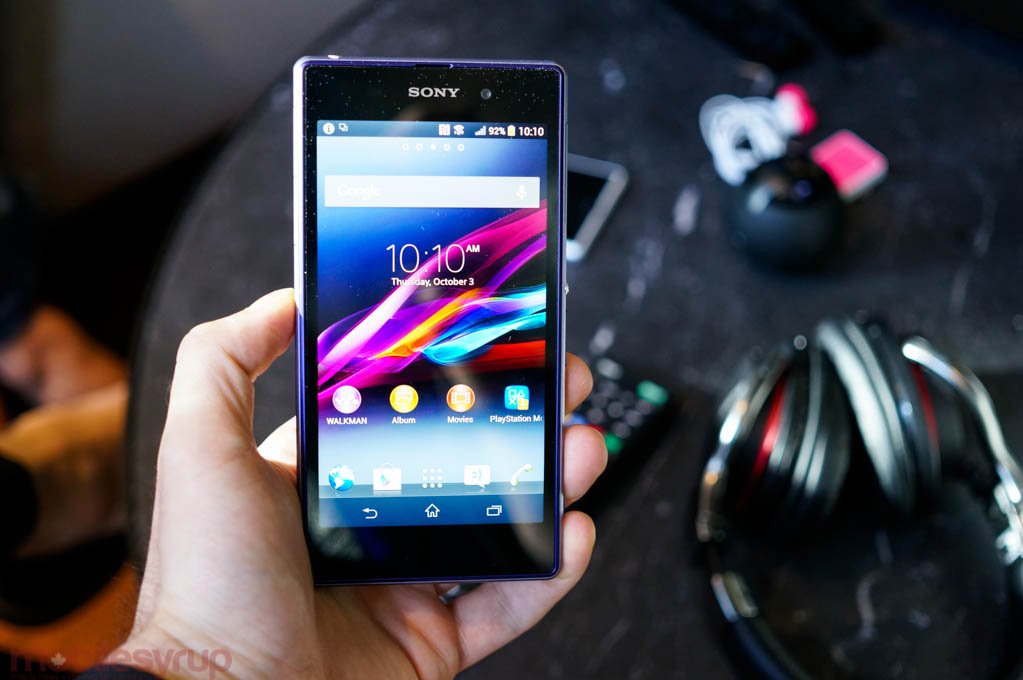
If there’s been one constant in the Android OEM community over the past two years, it’s Sony’s seeming inability to keep up with the competition. Though the last two years have seen the company continue to be one of the only to debut new mobile hardware at CES, each time — the Xperia S and ion in 2012; the Xperia ZL and Z in 2013 — there were elements, either software- or hardware-based, that held the company back.
With the follow-up to the Xperia Z, appropriately called the Xperia Z1, Sony is not content to fall behind again. Instead, the struggling Japanese juggernaut has cordoned off a couple sections of the industry — water ingress and camera optics — to differentiate from the pack. The Xperia Z1 is not only a wonderfully capable Android smartphone in its own right, but proves that Sony can successfully distinguish itself from Samsung, LG, HTC et al by focusing on doing a few things very, very well.
Specs
- Android 4.2.2 Jelly Bean
- 5-inch 1920×1080 LCD display w/ Triluminos imaging
- 2.3Ghz Qualcomm Snapdragon 800 SoC w/ Adreno 330 GPU
- 2GB RAM / 16GB internal storage (+microSD slot)
- 20.7MP rear sensor (1/2.3 inches) w/ BIONZ processor + f/2.0 G Lens
- 2MP front-facing sensor
- IP58 certified: Dustproof, water resistant up to 1m for 30min
- WiFi (a/b/g/n/ac), Bluetooth 4.0 LE, A-GPS, NFC,
- 1080p video capture
- HSPA+ 850 / 900 / 1700 / 1900 / 2100 Mhz | LTE 700 / AWS / 2600 Mhz
- 144 x 74 x 8.5 mm
- 170 grams
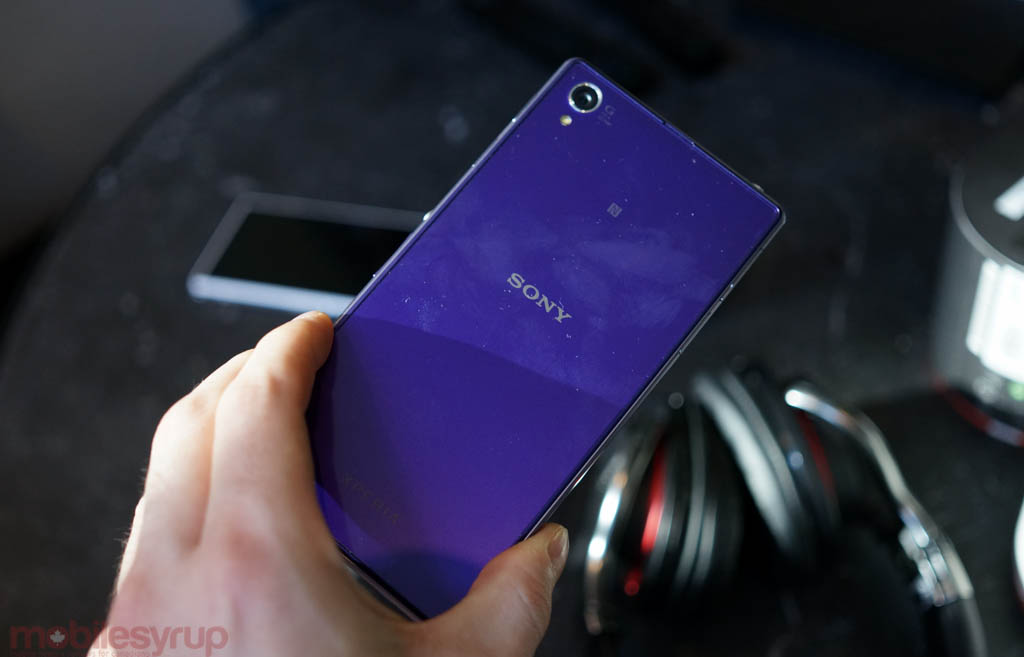
Device & Display
The Xperia Z1 is a big phone: it is taller and wider than its predecessor, the Xperia Z, and feels significantly larger than the ZL. In truth, because the device is so wide, it is actually less easy to grip than competitors’ phones with bigger screens, like the LG G2.
But there is a reason for the bulk-up: the 20.7MP camera sensor is 1/2.3 inches, much larger than the 13MP shooter on the Z, and the largest currently available on an Android smartphone. Similarly, the IP58 certification means that Sony had to rearrange some of the circuitry to make the phone less susceptible to the elements. Such changes are thusly important to facilitate the phone’s two selling features: waterproofing and camera quality.
Otherwise, the Z1 is similar in design to the Xperia Z: it’s real boxy, with only slight curvature of the corners, and a hefty metal frame covered on both sides by Dragontrail, a Gorilla Glass competitor less prone to shattering (but slightly more prone to scratching)
. To ensure the phone remains impervious to liquid damage, all the ports, from the SIM to microSD to microUSB, are secured with clips. The phone is only secure when all the tabs are firmly in place, and they’re a necessary irritant (though there is an optional magnetic dock accessory for charging); the headphone jack, however, located on the top left of the device, can fill with water without shorting the innards.
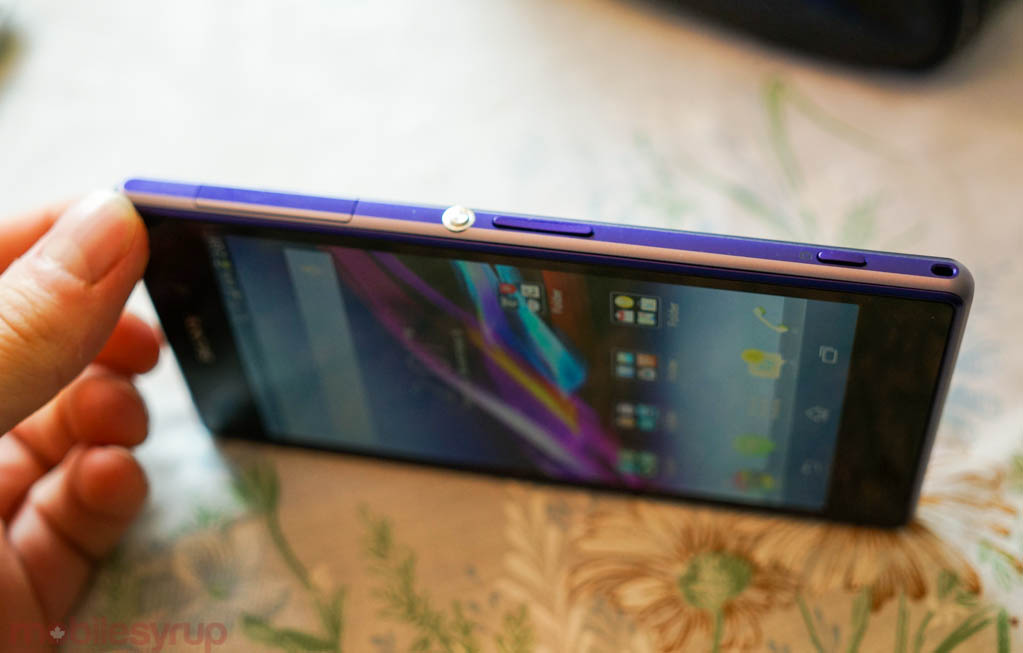
Large as it is, the Xperia Z1 is relatively comfortable to hold, and the right side contains all the phone’s important buttons, from the machine-beveled centre power button to the dual-step camera shutter. As always, you can enter the camera app at any time by holding down the shutter button, and we found response time to be excellent — under a second from cold off to ready-to-shoot.
The rear of the device houses the 20.7MP camera sensor that has no extrusion to speak of, a nice change from the Samsung Galaxy Note 3 and LG Nexus 5. The entire backing is covered with reinforced, shatter-resistant glass, but along both sides there is a distinct perimeter between the glass and bezel that is quick to attract dust and dirt. The problem was present in the Xperia Z and is probably a necessity of the manufacturing process but it doesn’t forgive the fact that after a few months this phone is not going to look pristine.
The display is another area that Sony worked hard to improve. The Xperia Z1’s predecessor, though it housed a 1080p of the same size and resolution, was underwhelming. Colours were washed out, especially if looked at left or right of centre, and black levels were a notch below grey. The situation is considerably improved here — Sony calls the underlying technology Triluminos, adapted from the calibration technology of the same name from the company’s Bravia television line — but still doesn’t best its mainline competitors. This is a vexing realization, too, as Sony continues to boast of its display efficacy in other industries, but can’t seem to procure panels with ideal viewing angles. And that really is the only area in which this LCD screen suffers: Sony has solved the colour saturation issues, and whites are accurate and blacks deep. But look at it a few degrees off centre and you’ll be seeing an entirely different colour spectrum.
Of course, the fact that the Xperia Z1 is waterproof for one metre up to 30 minutes makes it very useful to anyone less than careful with their smartphone. It’s a remarkable relief not to have to worry about where I place the phone, indoors or out. While it’s launching as winter approaches, it will be fantastic to use during the summer: take it to the cottage, to the pool, take photos underwater. It’s a very cool experience. That it can be washed in the sink when dirty or dusty, too, is a relief.
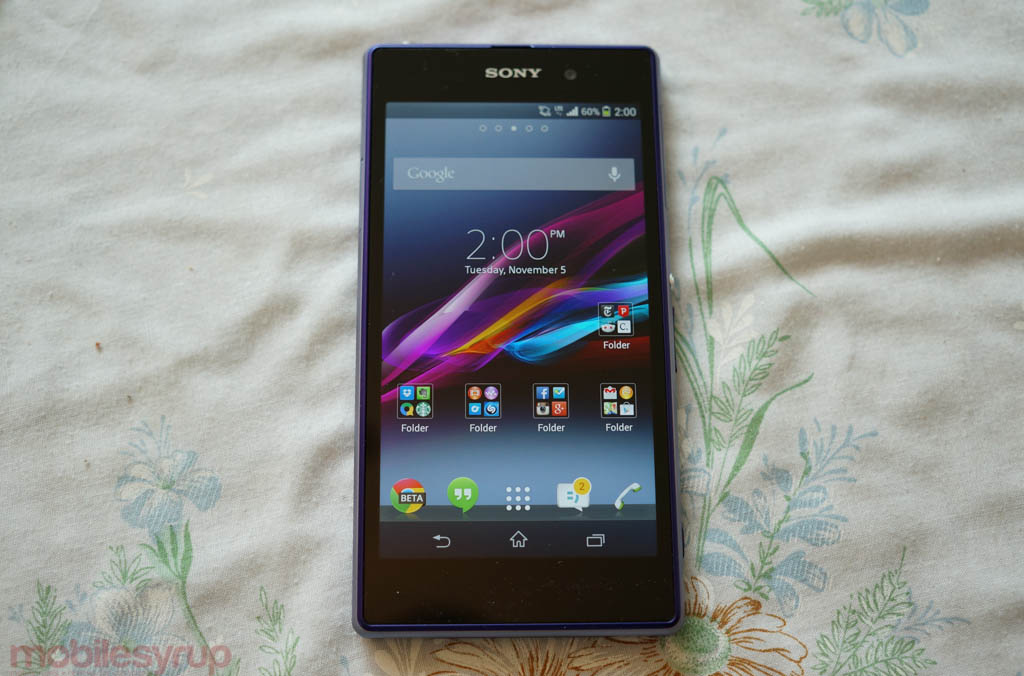
Performance & Software
The Xperia Z1 is not behind the competition in performance; this is a device running the very latest Qualcomm chipset, running a build of Android that has clearly been optimized for speed. While it wasn’t always the case, Sony has managed to find the right balance between value-add services (in the form of apps) and adhering to the basic tenets of Android design.
Running Android 4.2.2, the experience will feel remarkably similar to someone coming from a Nexus device. From on-screen navigation buttons to a four-icon dock and easy folder creation, the launcher is easy to use. To wit, the app drawer has a left-side sliding menu that lets users sort apps according to Most Used, Alphabetical and Own Order. It’s similarly easy to rearrange apps according to one’s own preferences.
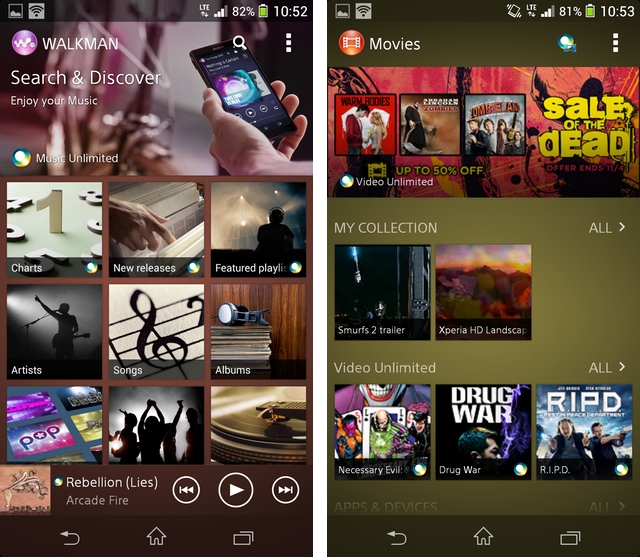
There’s a considerable amount of pre-installed software, but to Sony’s credit very little of it feels superfluous. From the excellent gallery replacement, Album, to the tight Music Unlimited integration in WALKMAN, Sony has focused a lot of its attention in deriving value from its tremendous breadth of content, be it music, movies, PlayStation and products. But rather than merely being an ad vehicle for other Sony products, the Xperia Z1 appears to take a middle ground approach, offering promo content like two months of Music Unlimited along with every purchase, six movies from Video Unlimited and 12 free PlayStation Mobile games.
Without those perks, though, Sony’s software would still feel incredibly fast. Apps open quickly and scrolling is smooth; the phone benchmarks within a few degrees of its peers, though at this point differentiating between them is less than meaningful. Where the Xperia Z1 excels is stability and first-party apps: Sony has a tremendous knack for Android design, and it shows in every app it builds. The Album app, aka Gallery, indexes quickly, navigates smoothly and integrates with services like Facebook, Picasa, Flickr and Sony’s own PlayMemories. It also does some pretty neat things with the camera app, as we’ll see in the next section.
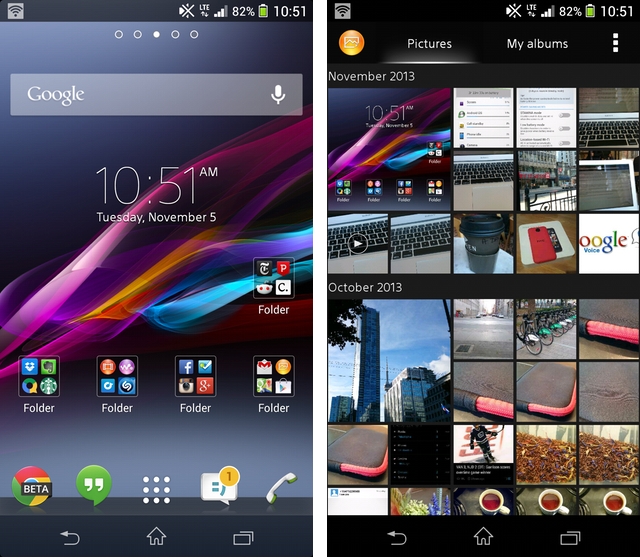
Sony’s problem is an issue facing every Android OEM not named Samsung; its skin has no specific gimmick to get you in the door, no defining feature that may or may not work. While its NFC integration is excellent, and a growing ecosystem of Sony products, from headphones to speakers to televisions, takes advantage of it, the software is merely a vehicle for its excellent hardware. Sony already has established brands — PlayStation comes to mind — but doesn’t knock you over the head with them. You can choose to use Music or Music Unlimited, but the phone will never nag you to do so.
Another benefit of using Sony’s skin is its excellent battery controls: there is a dedicated Power Management section, inside which you can enable the excellent Stamina Mode. A highly-touted feature that debuted in previous Xperia products, Stamina Mode really excels on the Xperia Z1. When enabled, mobile data and WiFi are not used when the screen is off; the beauty, though, is that you can add certain apps to a whitelist that will still push notifications when in standby. There’s also a Location-based WiFi mode, a feature that hooks into a known network when in range, even if WiFi itself is turned off.
I can only evaluate a high-end Android smartphone these days by the experience I have with it. To say that the Xperia Z1 doesn’t stand out, is not particularly noteworthy in the performance or software department, minimizes the many small successes that contribute to a fantastic UX. Sony is a great Android OEM — one of the best, in fact — and aside from a few issues with size and display quality, the Z1 is one of its best smartphones.
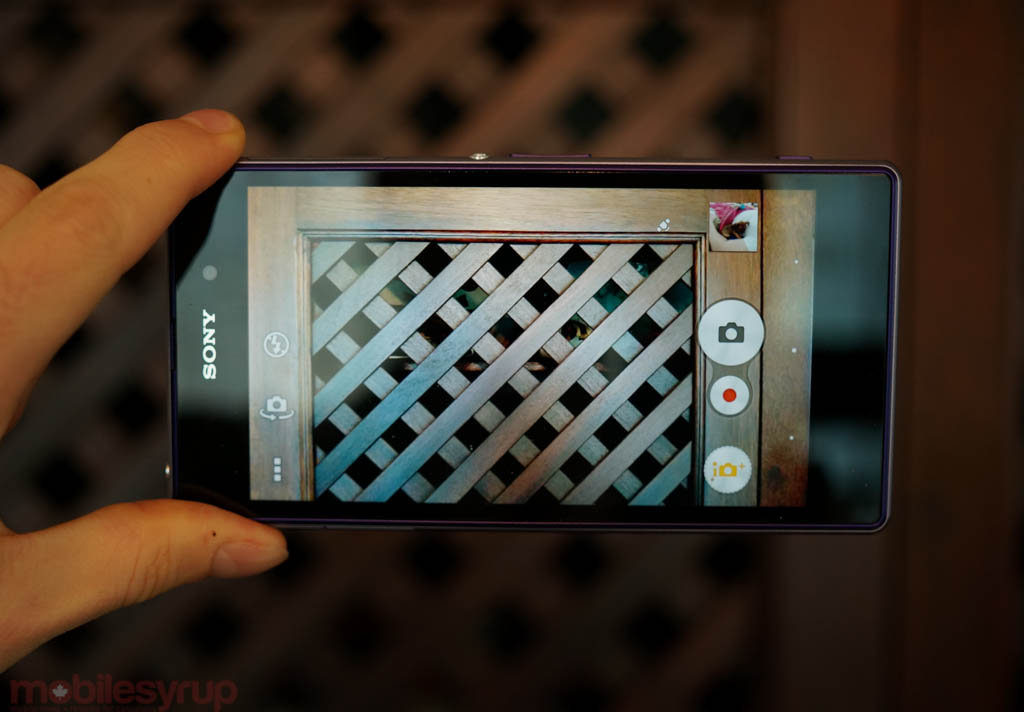
Camera
Sony has not shied away from promoting its imaging capabilities, and the Xperia Z1 doesn’t disappoint. While previous versions of the device have emphasized megapixels over quality — the Xperia T was one of the first in-market handsets with a 12MP camera — this year, Sony isn’t exaggerating. With a few exceptions, the Xperia Z1 provides the best overall photo experience on Android, bested only by the iPhone 5s and Nokia Lumia 1020 on other platforms. That’s not to say the former always provides better photos or the latter more comprehensive shooting, but the Xperia Z1 finds a fantastic balance of both.
By default, the camera app shoots in a mode called Superior Auto, which determines the best preset based on lighting and subject matter. Most of the time, the result is excellent; the f/2.0 lens is fast and Superior Auto usually chooses correctly. If you want more control, however, changing to Manual mode enables different aspect ratios — SA defaults to 8MP at 16:9 — and full-resolution mode. It also allows users to alter white balance and various scenes, like Night Scene, Anti Motion Blur and Portrait.
I did have some issues focusing on nearby objects with the Z1, especially in areas of lower light, but found it easy to step back and later crop the image. As you can see from the comparison photos, the Z1 took the cleanest, least noisy low-light shots between it and the iPhone 5, LG G2 and Nexus 5, and certainly the most balanced of the indoor lighting shots. The only area in which it struggled was to find a foreground object to focus on in the doorknob photo.
Like the Lumia 1020, the Xperia Z1 uses the 20MP lens captures smaller 8MP photos and uses the extra data to cut down on noise and improve detail. This is most evident in low light situations, in which the Xperia Z1 excels. I still noticed a muddiness to some of the photos, and noise was still a major issue when light was scarce, but the majority of photos focused quickly and turned out very well. It’s also nice to have a lens that actually enables true depth of field, albeit in a limited capacity.
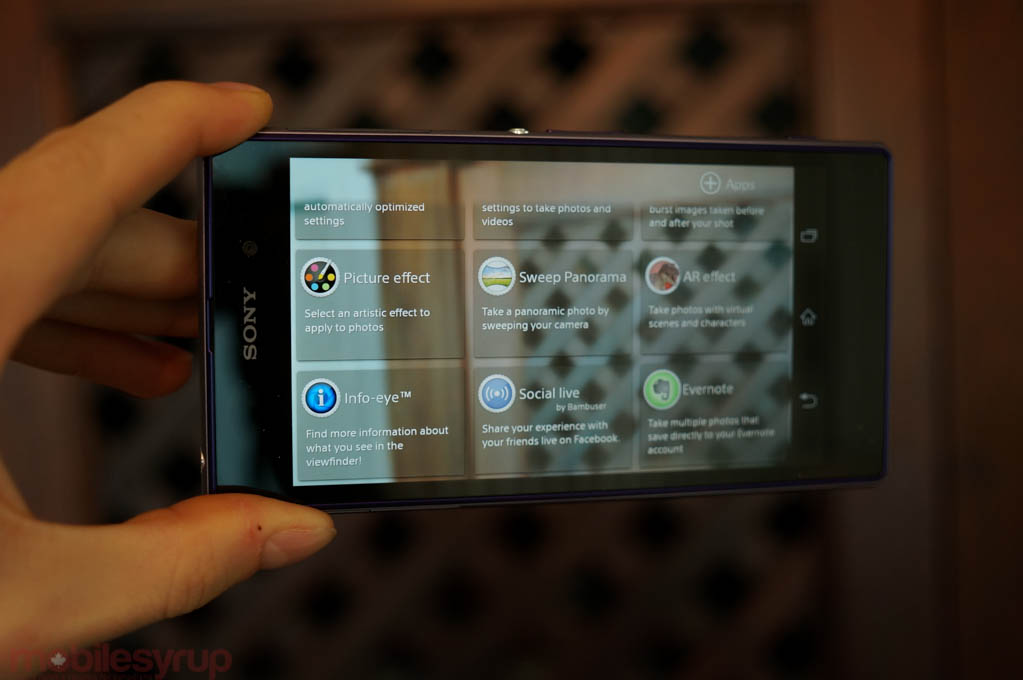
But Sony wasn’t content pushing just the phone’s technical superiority; there are a number of camera-centric apps included with the phone. Info-eye uses the viewfinder as a mechanism for search; take a photo of a book or wine label and derive its origin, its name, etc. I found it to work quite well, provided the subject itself was thoughtfully captured. Sony partnered with third-party providers like Vivino for wine label and Amazon for book identification, and though similar features are available from other apps in the Play Store, the integration with Sony’s camera app is ideal for frequent use.
Other camera “apps” like Social Live were less useful, but I don’t think I’m the right use case for such a feature. Social Live allows users to broadcast a video stream, USTREAM-style, to Facebook in real time. It works well for public events that would be great to watch at home or on the go, but the unedited, uncensored nature of the broadcast limits its potential use cases.
Sony also partnered with Evernote to automatically upload multiple photos to a user’s account, and there’s an excellent Sweep Panorama mode that makes me feel better about not having Google’s Photosphere.
The Z1 captures 1080p video at 30fps, and though it lacks the 4K support of the Galaxy Note 3, I found the video quality to be uniformly excellent. Software-based video stability ensures shakiness is rarely an issue, though it would be nice to have on-board optical image stabilization like on the Lumia 1020 and LG G2. Still, the BIONZ for mobile processor did not freak out at quick changes in light and movement, and I’d rank the Xperia Z1 at the top of the heap in terms of video capture.
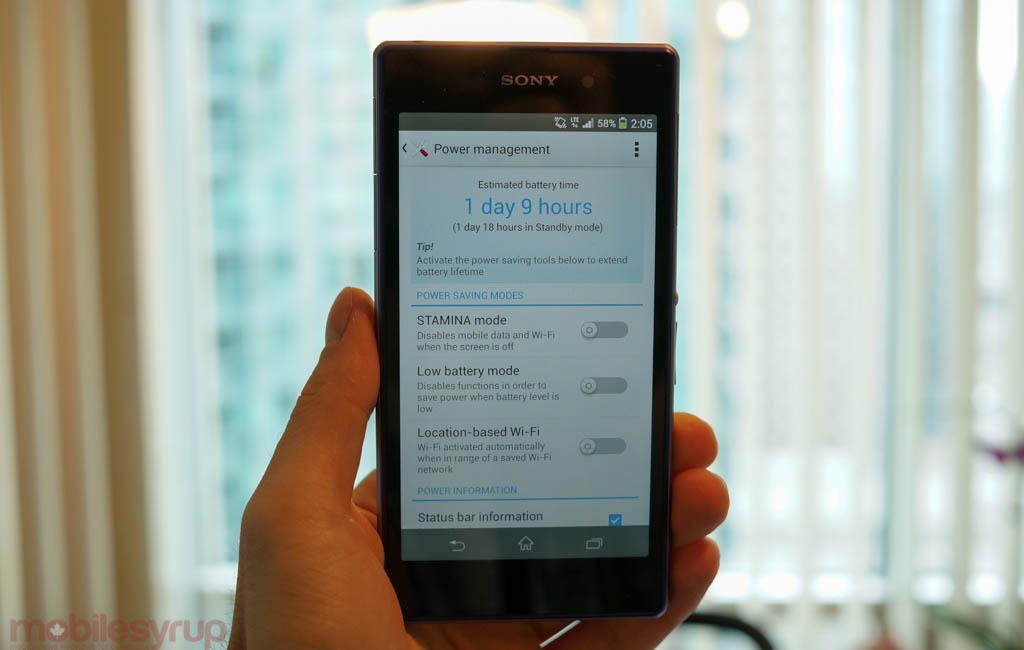
Connectivity & Battery Life
As opposed to previous Xperia smartphones, the Z1 lasts a long, long time. A built-in 3000mAh battery alone would be enough to ensure all-day usage, but Sony’s software optimizations — there are very few excess processes in the background — and the optional Stamina Mode helped boost the Xperia Z1 to the top of the Android pack, right behind the Galaxy Note 3 and just ahead of the LG G2.
I was able to get around 9 hours of continuous video playback from the device, but in regular usage it lasted well into a second day. Between 18 and 24 hours of moderate usage was not uncommon.
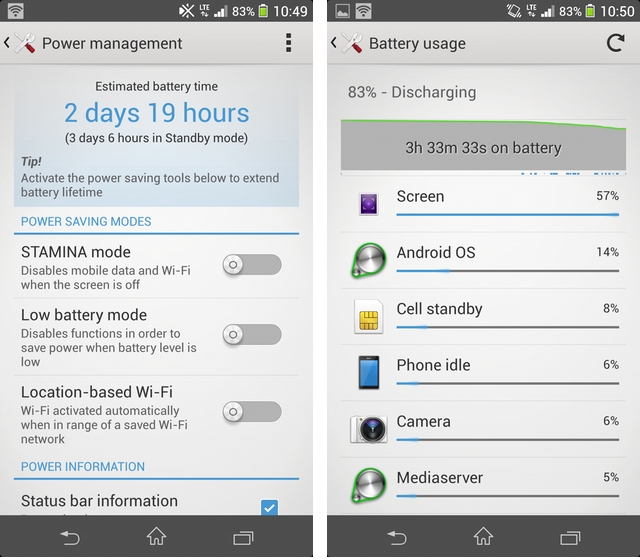
I tested the purple version of the Xperia Z1, a Rogers exclusive (it also comes in white and black, the former a Bell exclusive, the latter available on all), which has been optimized for 2600Mhz. Suffice it to say, like previous LTE Max devices, the Xperia Z1 was plenty fast, regardless of testing area. While it was impossible to determine whether the phone was connected to AWS or 2600, I rarely wanted for extra speed, even when testing on crowded downtown Toronto nodes.
Sony has never been well known for its excellent phone call quality, but the Xperia Z1 provided a decent experience for calling. The bottom-facing mono speaker, too, was middle of the road — neither disappointing nor extraordinary.
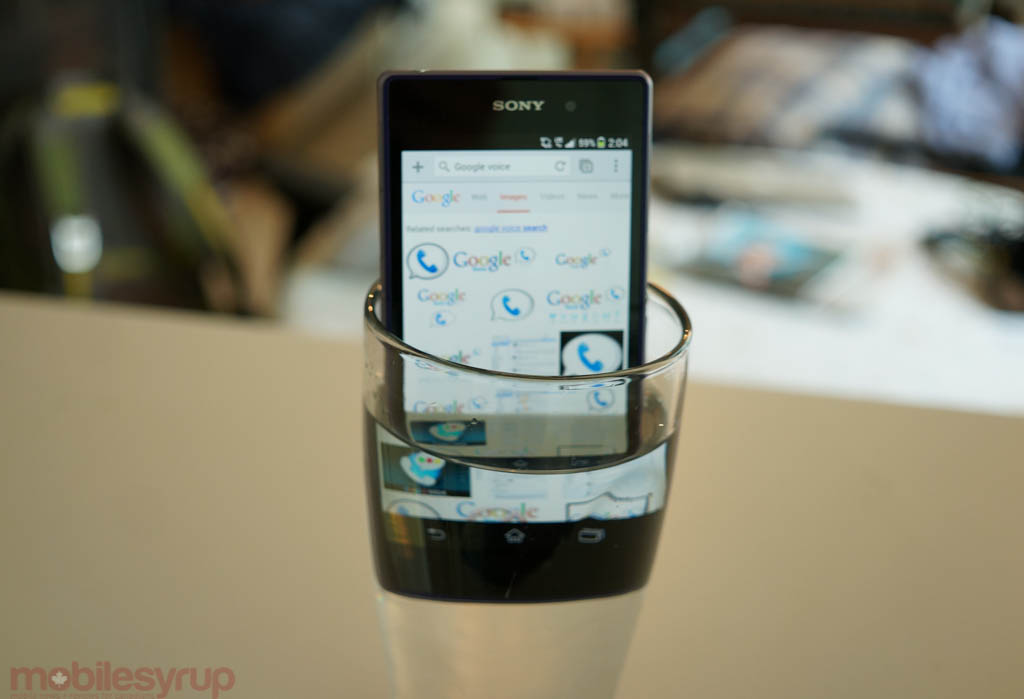
Conclusions
The Sony Xperia Z1 enters the market at a busy time for Android devices, and smartphones in general. But unlike former Xperia smartphones, the Z1 manages to go head-to-head with most of its competition in nearly every category. While the display disappoints relative to gorgeous offerings by LG, Samsung and HTC, it’s a big step up from the Xperia Z/ZL, and will satisfy the vast majority of discerning users. More importantly, the slightly oversized chassis facilitates the phone’s two main selling features: waterproofing and an amazing camera.
The former is a slow burner: you won’t realize how useful it is until you take advantage of it. The second is immediately gratifying: the 20.7MP camera is a wonderful addition to the Android ecosystem, and is enough, in my opinion, to be the deciding factor between the Z1 and another handset. This time, it’s not just about the higher number of pixels, but the size of the sensor itself, along with a lens optimized for such a combination.
In terms of software, Sony continues to take the less-is-more approach, burdening the user less with choice than content. Sony’s music, video and games offerings provide an alternative to Google Play, and while they may only be tantalizing to users already subscribing on another platform, choice is good.
Ultimately, there is very little for which to criticize Sony this time around. The Xperia Z1 may not be as compact as the G2, nor as immediately feature rich as the Galaxy S4 or as beautiful as the HTC One, but it’s a fantastic all-round smartphone choice.
MobileSyrup may earn a commission from purchases made via our links, which helps fund the journalism we provide free on our website. These links do not influence our editorial content. Support us here.


